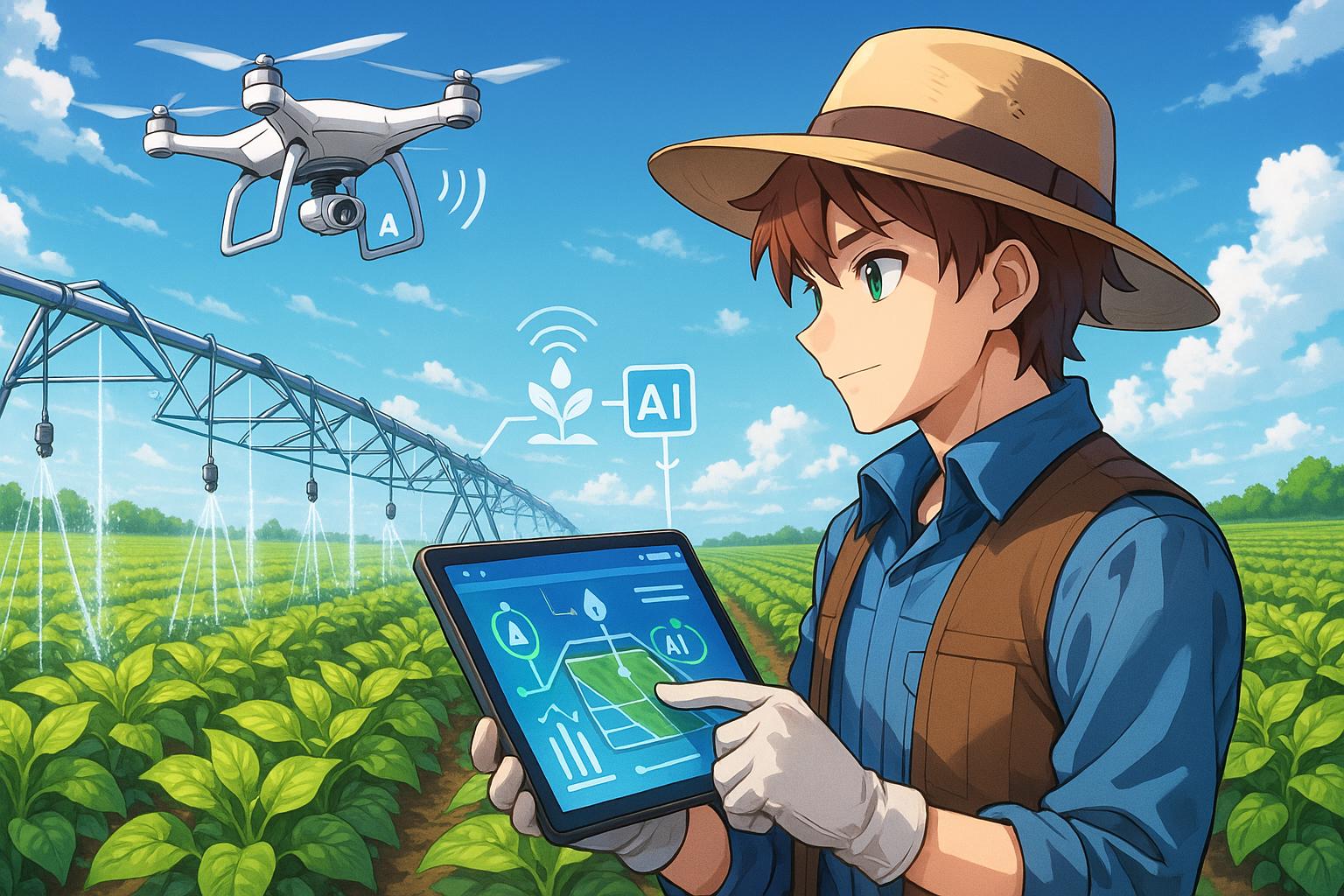Artificial intelligence is transforming traditional farming practices by enabling data-driven irrigation, pest management, and equipment operation. These innovations are helping farmers improve yields, reduce resource use, and overcome challenges such as connectivity and high costs, paving the way for a more sustainable agricultural future.
Farmers have traditionally relied on their instincts, experience, and observational skills to manage the complexities of agriculture. However, the advent of artificial intelligence (AI) is revolutionising these practices, ushering in a new era that marries technology with time-honoured methods. From optimising irrigation to predicting market trends, AI is helping farmers overcome age-old challenges with remarkable precision and efficiency.
One of the most significant advancements lies in precision irrigation. Instead of sticking to rigid watering schedules, AI systems now assess a multitude of factors—soil moisture levels, weather forecasts, and the specific needs of crops—to determine the optimal timing and amount of water required. This not only conserves water, often achieving reductions of 20-30%, but also enhances crop yields. For instance, an AI-powered system in California’s Central Valley demonstrated a 27% decrease in water consumption while maintaining robust crop production. Such data-driven strategies align with the growing demand for sustainable practices in farming.
Similarly, AI has transformed pest and disease management. Advanced sensor technologies and machine learning models can now analyse crop images and detect signs of disease or pest infestations with up to 90% accuracy, a vast improvement over traditional inspection methods. This proactive approach allows farmers to implement targeted interventions, significantly reducing reliance on chemical pesticides—some AI applications have reported reductions in herbicide use by as much as 90%. This technological shift not only preserves environmental integrity but also supports healthier farming practices.
The integration of AI into farm equipment has further enhanced operational efficiency. Modern tractors equipped with geospatial data capabilities can construct precise soil and crop maps, guiding farmers on field variability and crop health. AI-powered sprayers can differentiate between crops and weeds, adapting their spray patterns accordingly, thereby minimising chemical use and lowering operational costs.
To leverage these technologies effectively, farmers rely on a wealth of data gathered through various means: weather stations, soil sensors, satellite imagery, and advanced cameras mounted on tractors. With the costs of these technologies decreasing—from sensor setups that once cost upwards of $50,000 now available for around $15,000—more farmers can access these resources. However, processing this data either requires cloud technology or local edge computing solutions, catering especially to farms in remote areas where internet connectivity can be a hurdle.
Despite the promise that AI holds, questions around cost-efficiency arise. Basic AI setups for irrigation start at around $18,000, with comprehensive systems ranging from $75,000 to $150,000. While initial investments may be steep, many farmers see returns within 2-3 seasons, particularly with high-value crops. For example, a blueberry farm in Michigan recouped a $62,000 investment in AI in as little as nine months, thanks to improvements in yield quality and lower product losses.
Nevertheless, obstacles persist. Internet access remains inconsistent in roughly one-third of rural locales, prompting some farmers to invest in private networks—an expensive yet necessary venture for modern farming. Many farming tools are also antiquated, complicating the integration of new technologies; retrofitting older machines can incur costs ranging from $5,000 to $12,000. Another critical gap relates to talent, as there is a shortage of professionals who possess expertise in both AI and agriculture.
Moreover, ownership and use of data generated on farms are ongoing concerns. Clarity around data usage—specifically, who benefits when a technology provider employs farm data to refine its services—remains a grey area, necessitating transparent agreements. Some farmer cooperatives are taking matters into their own hands by developing proprietary data platforms to safeguard their information.
Looking forward, the landscape of farming continues to evolve with the integration of AI. Innovations such as precision weeding, targeted harvesting, and the analysis of soil microbiomes and plant genetics are on the horizon. Additionally, the availability of entry-level AI systems for under $10,000 could democratise access for smaller farms.
Ultimately, AI is not about replacing farmers but empowering them. By embracing smart technologies, farmers can enhance productivity, improve profitability, and cultivate resilience amid a shifting agricultural landscape—an imperative as global food demands intensify. For stakeholders across the agricultural sector—farmers, agritech innovators, and policymakers—now is the opportune moment to harness AI’s potential for a sustainable future.
Reference Map
1. [Lead Article: The real impact of AI on agriculture today]
2. [Related Article: Societal improvements through AI in agriculture]
3. [Research on AI and precision farming benefits]
4. [Exploration of AI’s role in pest and disease management]
5. [Examination of AI in crop monitoring and disease management]
6. [Discussion on AI-driven crop disease detection]
7. [Overview of precision agriculture and AI integration]
Source: Noah Wire Services
- https://www.thehindubusinessline.com/economy/agri-business/farming-gets-smarter-the-real-impact-of-ai-on-agriculture-today/article69584728.ece – Please view link – unable to able to access data
- https://www.ft.com/content/33ed8ad0-f8ad-42ed-983a-54d5b9eb2d27 – This article discusses how next-generation artificial intelligence (AI) can be harnessed to foster societal improvements, focusing on agriculture, healthcare, and environmental conservation. In agriculture, AI enhances precision farming, guides resource management, and improves yields using predictive models and smart technology. The report highlights the ethical considerations and the need to manage growing energy demands from AI, advocating for tailored small language models (SLMs) for specific purposes. Overall, while AI presents vast opportunities for societal benefits, careful implementation and balancing human elements are crucial for success.
- https://www.researchgate.net/publication/385540263_AI_in_Agriculture_Revolutionizing_Precision_Farming_and_Sustainable_Crop_Management – This research paper explores the transformative potential of AI in agriculture, particularly in precision farming and sustainable crop management. It discusses how AI-driven precision agriculture techniques can reduce water usage by up to 30%, fertilizer application by 20%, and herbicide use by 75%. The paper provides examples, such as an AI-powered irrigation system implemented in California’s Central Valley, which reduced water consumption by 27% while maintaining crop yields. These advancements demonstrate how AI enables data-driven decision-making, improving farm productivity and promoting sustainable practices.
- https://numalis.com/precision-farming-ai-revolution/ – This article delves into the unseen revolution of precision farming powered by AI. It covers various applications, including predictive pest and disease control, precision irrigation, yield prediction, and autonomous farming equipment. For instance, AI systems analyze historical data, weather patterns, and satellite imagery to predict pest outbreaks before they occur, allowing for targeted interventions. Additionally, AI-driven irrigation systems dynamically adjust schedules based on real-time data, optimizing water usage and enhancing crop yields. The piece emphasizes the significant impact of AI in transforming agricultural practices.
- https://www.researchgate.net/publication/385940131_AI_IN_AGRICULTURE_REVOLUTIONIZING_CROP_MONITORING_AND_DISEASE_MANAGEMENT_THROUGH_PRECISION_TECHNOLOGY – This research paper examines how AI is revolutionizing crop monitoring and disease management through precision technology. It highlights that approximately 65% of farmers who adopted AI technologies reported an increase in crop yields. The paper also notes that AI-powered drones equipped with machine learning models for identifying leaf diseases achieved a 90% detection accuracy, significantly higher than traditional visual inspections. These advancements demonstrate the effectiveness of AI in enhancing agricultural productivity and sustainability.
- https://link.springer.com/article/10.1007/s44279-025-00220-9 – This article discusses the applications of AI in precision agriculture, focusing on crop disease detection and pest control. It explains how AI-driven approaches, particularly Convolutional Neural Networks (CNNs), analyze images of crops to detect visual symptoms of diseases such as discoloration, lesions, and abnormal growth patterns. Additionally, AI plays a crucial role in pest control by utilizing machine learning and computer vision to detect and manage pest populations, enabling precise pest management strategies and reducing environmental impact.
- https://tomorrowdesk.com/disruptive-technology/precision-agriculture – This article explores how precision agriculture, powered by AI and sensors, optimizes farming practices. It covers areas such as precision irrigation systems, fertilizer management, and the benefits of AI-driven precision agriculture, including enhanced productivity, resource conservation, environmental sustainability, and economic benefits. For example, smart irrigation systems powered by AI analyze soil moisture data, weather forecasts, and crop water requirements to optimize water usage, leading to significant water savings and improved crop yields.
Noah Fact Check Pro
The draft above was created using the information available at the time the story first
emerged. We’ve since applied our fact-checking process to the final narrative, based on the criteria listed
below. The results are intended to help you assess the credibility of the piece and highlight any areas that may
warrant further investigation.
Freshness check
Score:
8
Notes:
The narrative does not reference any outdated information or individuals who have changed roles. It discusses current advancements in AI technology, suggesting a recent focus. However, the absence of specific recent events or timelines reduces the score slightly.
Quotes check
Score:
0
Notes:
There are no direct quotes in the narrative to verify.
Source reliability
Score:
9
Notes:
The narrative originates from The Hindu BusinessLine, a reputable publication known for its reliable reporting on business and economic issues.
Plausability check
Score:
9
Notes:
The claims about AI’s impact on agriculture, such as precision irrigation and pest management, are plausible and supported by the trend of integrating technology into farming practices. The narrative aligns with current technological advancements in agriculture.
Overall assessment
Verdict (FAIL, OPEN, PASS): PASS
Confidence (LOW, MEDIUM, HIGH): HIGH
Summary:
The narrative is well-supported by current trends in AI integration in agriculture, from precision irrigation to pest management. It originates from a reputable source, The Hindu BusinessLine, further enhancing its reliability. The absence of direct quotes and specific recent events does not significantly impact the overall assessment.













